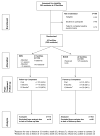Results of a randomized controlled trial to examine the efficacy of a chronic pain self-management group for older adults [ISRCTN11899548]
- PMID: 18086516
- PMCID: PMC2536565
- DOI: 10.1016/j.pain.2007.11.003
Results of a randomized controlled trial to examine the efficacy of a chronic pain self-management group for older adults [ISRCTN11899548]
Abstract
Chronic pain is a common, disabling problem in older adults. Pain self-management training is a multimodal therapy that has been found to be effective in young to middle-aged adult samples; however, few studies have examined the effectiveness of this therapy in older adults. In this randomized, controlled trial, we evaluated a pain self-management training group (SMG) intervention as compared with an education-only (BOOK) control condition. Participants, 65 years of age or older who experienced persistent, noncancer pain that limited their activities, were recruited from 43 retirement communities in the Pacific Northwest of the United States. The primary outcome was physical disability, as measured by the Roland-Morris Disability Questionnaire. Secondary outcomes were depression (Geriatric Depression Scale), pain intensity (Brief Pain Inventory), and pain-related interference with activities (Brief Pain Inventory). Randomization occurred by facility to minimize cross-contamination between groups. Two-hundred and fifty-six individuals, mean age=81.8 (SD: 6.5), enrolled and 218 completed the study. No significant differences in outcomes were found between groups at post-intervention, 6-month follow-up, or 12-month follow-up. The SMG group showed a significantly greater increase over time, relative to the BOOK group, in two process measures, as measured by the Chronic Pain Coping Inventory: use of relaxation and use of exercise/stretching. In both cases, the increase was greatest from baseline to the post-intervention assessment. Study findings indicate that additional research is needed to determine the most effective content and delivery methods for self-management therapies targeted at older adults with chronic pain.
References
-
- American Geriatrics Society. The management of persistent pain in older persons. J Am Geriatr Soc. 2002;50:S205–224. - PubMed
-
- American Pain Society. Guideline for the management of pain in osteoarthritis, rheumatoid arthritis and juvenile chronic arthritis
-
- Beurskens AJ, de Vet HC, Koke AJ. Responsiveness of functional status in low back pain: a comparison of different instruments. Pain. 1996;65:71–76. - PubMed
-
- Blyth FM, March LM, Nicholas MK, Cousins MJ. Self-management of chronic pain: a population-based study. Pain. 2005;113:285–92. - PubMed
-
- Caraceni A, Cherny N, Fainsinger R, Kaasa S, Poulain P, Radbruch L, De Conno F. Pain measurement tools and methods in clinical research in palliative care: recommendations of an Expert Working Group of the European Association of Palliative Care. J Pain Symptom Manage. 2002;23:239–255. - PubMed
Publication types
MeSH terms
Associated data
Grants and funding
LinkOut - more resources
Full Text Sources
Medical


